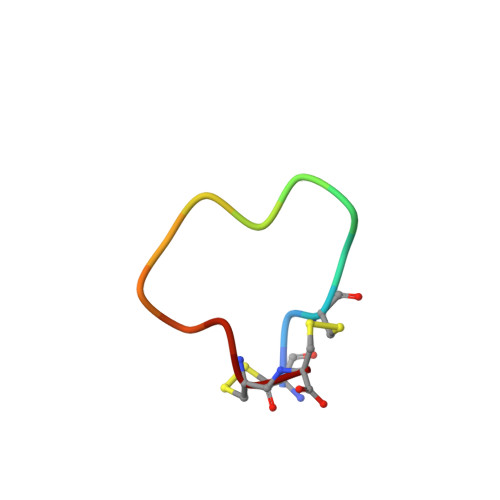Design of bioactive peptides from naturally occurring mu-conotoxin structures.
Stevens, M., Peigneur, S., Dyubankova, N., Lescrinier, E., Herdewijn, P., Tytgat, J.(2012) J Biological Chem 287: 31382-31392
- PubMed: 22773842
- DOI: https://doi.org/10.1074/jbc.M112.375733
- Primary Citation of Related Structures:
2LU6 - PubMed Abstract:
To date, cone snail toxins ("conotoxins") are of great interest in the pursuit of novel subtype-selective modulators of voltage-gated sodium channels (Na(v)s). Na(v)s participate in a wide range of electrophysiological processes. Consequently, their malfunctioning has been associated with numerous diseases. The development of subtype-selective modulators of Na(v)s remains highly important in the treatment of such disorders. In current research, a series of novel, synthetic, and bioactive compounds were designed based on two naturally occurring μ-conotoxins that target Na(v)s. The initial designed peptide contains solely 13 amino acids and was therefore named "Mini peptide." It was derived from the μ-conotoxins KIIIA and BuIIIC. Based on this Mini peptide, 10 analogues were subsequently developed, comprising 12-16 amino acids with two disulfide bridges. Following appropriate folding and mass verification, blocking effects on Na(v)s were investigated. The most promising compound established an IC(50) of 34.1 ± 0.01 nM (R2-Midi on Na(v)1.2). An NMR structure of one of our most promising compounds was determined. Surprisingly, this structure does not reveal an α-helix. We prove that it is possible to design small peptides based on known pharmacophores of μ-conotoxins without losing their potency and selectivity. These data can provide crucial material for further development of conotoxin-based therapeutics.
- Laboratory of Toxicology, Katholieke Universiteit (KU) Leuven, Campus Gasthuisberg O and N2, Herestraat 49 Box 922, 3000 Leuven, Belgium.
Organizational Affiliation:
















